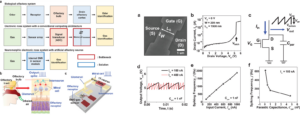Abstract
A neuromorphic module of an electronic nose (E-nose) is demonstrated by hybridizing a chemoresistive gas sensor made of a semiconductor metal oxide (SMO) and a single transistor neuron (1T-neuron) made of a metal-oxide-semiconductor field-effect transistor (MOSFET). By mimicking a biological olfactory neuron, it simultaneously detects a gas and encoded spike signals for in-sensor neuromorphic functioning. It identifies an odor source by analyzing the complicated mixed signals using a spiking neural network (SNN). The proposed E-nose does not require conversion circuits, which are essential for processing the sensory signals between the sensor array and processors in the conventional bulky E-nose. In addition, they do not have to include a central processing unit (CPU) and memory, which are required for von Neumann computing. The spike transmission of the biological olfactory system, which is known to be the main factor for reducing power consumption, is realized with the SNN for power savings compared to the conventional E-nose with a deep neural network (DNN). Therefore, the proposed neuromorphic E-nose is promising for application to Internet of Things (IoT), which demands a highly scalable and energy-efficient system. As a practical example, it is employed as an electronic sommelier by classifying different types of wines.
